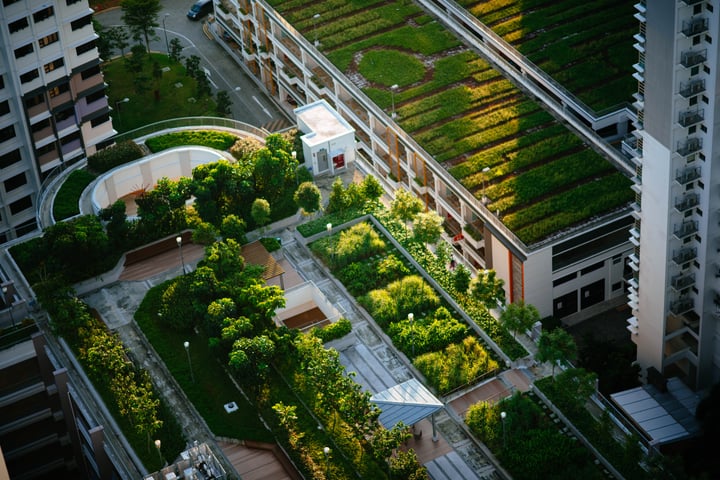The realistic industry trends for 2024
Modern times: a history of industrial revolutions Understanding the future always demands us to look at the past. Since the 18th century, industry...
2024 is almost here and with it, many changes come in the sustainability transformation domain. Learn about some of the game-changers for next year and how you can adapt to the new market they will shape, helping both the environment and your business.
Image by © Chuttersnap via Unsplash
Published in Our tips

It is finally here! The realistic sustainability trends are here to complete our business transformation trilogy. If you haven’t read our previous articles, check the digital and industry transformation trends for 2024 and gain the full picture for next year.
This time we talk about sustainability, a topic that hasn’t ceased to grow in the previous years and that will continue to do so in the following. An increase in consumers’ demands for more social responsibility, regulations from different institutions and organisations along with a wider range of developments that allow businesses to be greener entered the game and changed the rules forever.
In this article, we bring you different trends that will be relevant next year, whether they are changes needed in internal procedures that concern how they conduct their business or innovative trends that will widen the possibilities of how things can be done.
As we mentioned in one of our previous articles, IT and sustainability are bound to collaborate in the future and such a combination will bring advances like we have not seen before.
Climate-positive tech, for example, is born from a different perspective to the traditional sustainable point of view. The tendency used to be to follow the reducing route, in which we try to reduce our waste (any kind of it) to the lowest level possible.
This new climate-positive perspective is born from the need to impact the environment, but this time in a positive way to fix the caused damage. Some examples of these technologies are the ones that allow the reduction of carbon emissions through their absorption, storage, and transformation into new products.
Sustainable IT, on the other hand, doesn’t necessarily have to try to reverse the environmental damage, but it can reduce our impact using technology in a way that allows us to use our resources more smartly. There are three main areas to consider when we talk about sustainable IT:
1. Substitution of materials: traditionally, technological devices are constructed with materials that present a challenge when we need to dispose of them because of how pollutant they are or their impossibility of being recycled. In this stage, we should look for alternatives for those materials, something that is more accessible now that we have more advanced knowledge and means.
2. Prevention: with that knowledge and those means we are more able than ever to know how our actions will impact our surroundings. Due to that anticipation capacity, we will have access to the problem before they even happen and, hence, to the possibility of changing the roadmap to find a more suitable solution to the green compromise.
3. Efficiency: technology consumes resources like electricity and thus, one of the pursued goals of green IT is making processes and machines as efficient as possible, for them to consume only the required amount of resources. Thanks to AI, for example, we can predict the most efficient process to complete an action, something that escaped our grasp just a few years ago.
The ESG framework will gain importance internationally and several corporations are ready to release their regulations on the topic. Our changing world tends to digitalisation and globalisation nowadays, so more general rules are now ready to be enforced. There are still differences, but technology is more accessible than ever and with it comes the possibility of acting more sensibly towards the environment.
Many countries will ask for companies to present their environmental and climate risk report in 2024. Looking no further, the EU will ask for companies subject to the CSRD to report to the European Sustainability Reporting Standards, starting in 2024.
Next year we will face mandatory reports for different requestors to show transparency in methods, present a sustainability plan, and to summarise, everything needed to know if we comply with said requirements. Not doing so will result in sanctions, while passing this test will increase the company's reputation.
Greenwashing will soon be controlled, due to its occurrence's growth after sustainability became an attractive factor for the consumer. Deceitful publicity will be pursued, and all data will need to be verifiable and compliant with the guidelines stipulated by the corresponding market.
The arrival of this sustainability wave of regulations will also bring a new wave of positions and responsibilities. All the teams that vertebrate a company are very likely going to be examined from a sustainable point of view and changes will be implemented as needed. So, prepare for the presence of new roles like sustainability manager, sustainability consultant (give us a call if you need one), carbon accountant and many others.
An area that will definitely be affected by this green tsunami is the financial one. We are not far from a reality in which most companies compile a financial report reflecting the opportunities and risks associated with adopting specific sustainable practices.
Sustainability metrics will be incorporated in the risk analysis and this new branch will help to continue developing tools and methodologies used in the financial area.
Not only will it be involved in risk analysis but in investment as well. The investment will be directed primarily to green causes (or green companies) and we will find new players in the financial sphere, like green bonds or responsible investment funds. These will be channels to inject funds into sustainable causes, so depending on the side your company is on, you could direct some of your investment to sustainable causes or, if you want to attract some funding, going green is a good strategy.
In the end, eco-consciousness has left the exclusively ecological sphere to transform too into a potential economic gain.
In our previous articles, we mentioned the transformative power of AI, especially concerning prediction and efficiency. AI-driven tech has the potential to pave the way for a more sustainable future and a more respectful cohabitation of business and the environment.
One of the main advantages of AI is its capacity for analysing big compilations of data and processing all of it to obtain the desired result. Thanks to this fast processing, businesses can expand, optimise their resources, become more energetically efficient and improve their processes without going through the trial and error method. This saves time and resources and considers all the variables for obtaining the best course of action.
The analytic function can also be applied to climate risk management, in other words, predicting extreme climate events that would affect the business and the other way around, predicting how the business’ activity would impact the environment. This gives businesses the upper hand in preparing and adapting to these hypothetical scenarios.
AI lets us open the door to innovation and conducts us to a more resilient business model as, in predicting the risks and the needs, it will allow us to push and have a defined objective. Becoming greener calls for innovative solutions which will reshape modern businesses. These new models will provide a better customer experience as well as help you stand out among your competitors.
In the last decade, we have witnessed a change of direction in the choice of energy sources. Right now, using non-fossil fuels is at hand reach for many businesses, much more than previously at least. A full transition is still complicated but mixed regimes and renewable energy implementations are commonplace for many businesses.
According to the International Energy Agency (IEA), we can look forward to a promising picture as in 2024, global renewable energy capacity will exceed 4,500 gigawatts, matching that of fossil fuels. Wind and solar power lead this transition and they will likely double their production next year. The forecast for Europe is even more promising as the geopolitical situation is pushing many EU members to rely less on gas and turn to renewables instead.
Electric power is the main alternative nowadays and further research on hydrogen is being pursued for widening the clean energy range of choice.
The switch of the type of energy used can also be accompanied by other measures that increase energy efficiency. Self-sufficient housing requires many innovations and services for such a reality to be fully attained, and the demand is increasing. The technology used for providing this type of housing can also be applied to industries, and offices as well as being a good business opportunity too.
Some of the advances related to this need that businesses can also profit from are the decentralisation of power production and the consequent production of your own energy or the bioclimatic architecture and sustainable design.
The final product or service provided to the client has as a goal to fulfil a need and reach the highest possible client satisfaction. The fact of changing that process in any way will need to be in sync with the consumer’s expectations. Looking back to 2020 and following a consumer sentiment survey made by McKinsey in the US, 60 % of consumers were willing to pay more for sustainable packaging. This data shows us that consumers are open to these changes but even so, campaigns for helping them understand the new positions or decisions taken will be needed.
If we are talking about a product, the most common choices for greener options are sustainable packaging, biodegradable waste, refill options, use of recycled materials and others. As for services, there are many green IT methods alongside new business ideas that align with the circular economy, recycling or any new need that arises from society.
If we want to examine a business to determine how sustainable it is, we have to contemplate every aspect, including providers, transportation and disposal. Institutions and consumers are calling for a more transparent supply chain and closer attention to detail when choosing the actors of their process.
Studying their supply chain is a way in which companies can pinpoint their scope 3 emissions, which are all the indirect emissions from a company’s activity. In fact, they make up the largest part of the carbon footprint of a company nowadays. Scopes 1 and 2 are more defined and can be monitored more easily. While scope 3 ones need a closer scrutiny to be found and solved. Actions must be taken to collect data, analyse it, report, and tailor solutions for the company but also its suppliers and partners. As we advance our ability to be sustainable, this green touch needs to extend to the whole company’s activity reach.
Transforming your business to be more environmentally friendly comes with a great set of advantages, not only the obvious protection of the planet. A more sustainable offer will attract both clients and stakeholders and with stricter regulations coming next year, it can even be the card for your business to thrive and be approved by regulatory institutions.
More than a choice, having a sustainable business will become a competitive advantage against others from the same sector and even a need for compelling with new rules. These are just some of the waves that will hit businesses' shores in the sustainability field. If you want to be a part of the sustainable transformation of businesses, check out our job offers page.

Modern times: a history of industrial revolutions Understanding the future always demands us to look at the past. Since the 18th century, industry...

What on earth is industrial transformation? By definition, industrial...

OpenClassrooms It's one of the most famous platforms in the training...